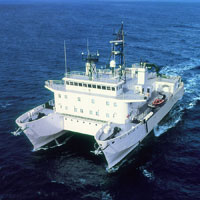- C-MORE Home
- What is Microbial Oceanography?
- What is C-MORE?
- Research
- • Research Cruises
- » Survey of Underwater Plastic and Ecosystem Response (SUPER)
- SUPER Home
- Lucy Marcus' Blog
- The Science Plan
- Cruise Report
- Science Personnel
- SUPER HI-CAT Wikipedia Article
- SUPER HI-CAT Data Links
- Education & Outreach
- People
- Publications
- Image Library
- Contact Us
Science on the SUPER Cruise
 Science Objective
Science Objective
To sample and characterize microbial community dynamics and ocean chemistry associated with plastic debris in the North Pacific Subtropical Gyre.
Goals
- Locate and quantify plastic debris in the North Pacific Ocean
- Estimate microbial diversity on plastic waste
- Compare bacterial production and respiration between free-living and plastic-associated microbial communities
- Characterize water column biogeochemistry and optical properties
Approach
We will visit 10–12 stations during a transit from Honolulu, HI to Port Hueneme, CA. At each station, we will conduct a 1–2 hour long net tow to collect plastic debris using a manta trawl, which was generously provided by the Algalita Marine Research Foundation. We will also sample 288 liters of seawater using a circular, 24-Niskin-bottle array. Finally, we will characterize the optical properties of the water column by performing 20-minute long HyperPro casts at each station.
This plan sounds straightforward, but in fact sampling will be a dynamic process that will be determined by weather, available science time, and location of the plastic debris. We require calm weather to conduct the plankton tows because not only does plastic accumulate at the surface in calm conditions, but the manta trawl works most effectively under a calm sea surface state. Also, the ship must arrive at Port Hueneme on time, so we only have a maximum of 48 hours of sampling time during the 12 day transit. Finally, we want to position ourselves within the North Pacific Subtropical Gyre, where the plastic is thought to be the most abundant. Therefore, we have to balance science time with travel time in order to get as far north as possible since we cannot conduct net tows or CTD casts while the ship is underway.
Using the water samples that we collect, we will analyze the water for:
- Dissolved oxygen (DO)
- Temperature
- Dissolved inorganic carbon (DIC) and Alkalinity
- Nutrients
- Low level nitrogen and phosphorus
- Dissolved organic carbon (DOC) — including proteins, amino acids, sugars
- Bacterial cell counts using flow cytometry
- ATP
- Particulates (carbon, nitrogen, phosphorus, and silica)
- DNA/RNA
- Bacterial production and respiration
 Operational Plans
Operational Plans
1: UW Stations 1-12
Underway stations will be conducted using the uncontaminated seawater supply system. Water samples for biogeochemical measurements will be collected at each UW station.
2: Stations 1-12
Upon arrival on station, a Manta trawl (see section 2.1) will be deployed. After the manta trawl operation is complete, a CTD cast to 75m for water column measurements will occur (see section 2.2).
2.1 Manta Trawls
A Manta trawl will be deployed for about 90 minutes off the stern. The ship will need to maintain a speed of 1-3 kts while the trawl is in the water. The A-Frame and capstan will be needed for this operation. The Manta trawl is rectangular with and opening of 0.9m x 0.15m and 3.5m long. Wake effects will need to be minimized during this operation.
2.2 Water column measurements
Vertical profiles of temperature, conductivity and dissolved oxygen will be made with an instrument package consisting of a Sea-Bird CTD attached to a 24-place rosette with 12 liter sampling bottles. We will need the ship’s CTD winch and crane for these operations. Water samples for biogeochemical measurements will also be collected on each cast. All CTD casts will be to 150m with a total of 6 depths sampled per cast.
2.3 HyperPro and LISST
At each station a hyperspectral profiling radiometer (HyperPro) and laser diffraction particle size analyzer (LISST)will be deployed from the main deck using the A-frame. These instruments are hand lowered and retrieved with assistance from the winch.
2.4 Acoustic Doppler Current Profiler
The ship’s acoustic Doppler current profiler (ADCP) will be in operation during the duration of the cruise. The OTG marine technician will be in charge of the ADCP system.
2.5 Thermosalinograph, Fluorometer and pCO2
The ship’s thermosalinograph, fluorometer and pCO2 sampling the uncontaminated seawater supply system will be in operation during the duration of the cruise while the ship is outside of Snug harbor. The OTG marine technician will be in charge of the thermosalinograph, fluorometer and pCO2 operations.
Summary Schedule
19 August | Pre-cruise Meeting |
23 August | Ship loading starting at 1000 hrs |
25 August | Depart from Snug harbor at 0700 hrs. Science personnel on-board by 0600 |
26 Aug – 4 Sept | Station 1-12 operations |
4 September | Pack, clean labs |
5 September | Arrive Port Hueneme, CA at 1500 hrs. Offload ship. |
Scientific operations
Station | Activities |
Stations 1–12 | CTD (0-150m) / Manta Traw l/ Optics Operations |
Underway Stations 1–12 | Various biogeochemical parameter sampling from uncontaminated seawater system |
Underway/Continuous | ADCP, Thermosalinograph, fluorometry, pCO2 |
[ Top of Page ]



